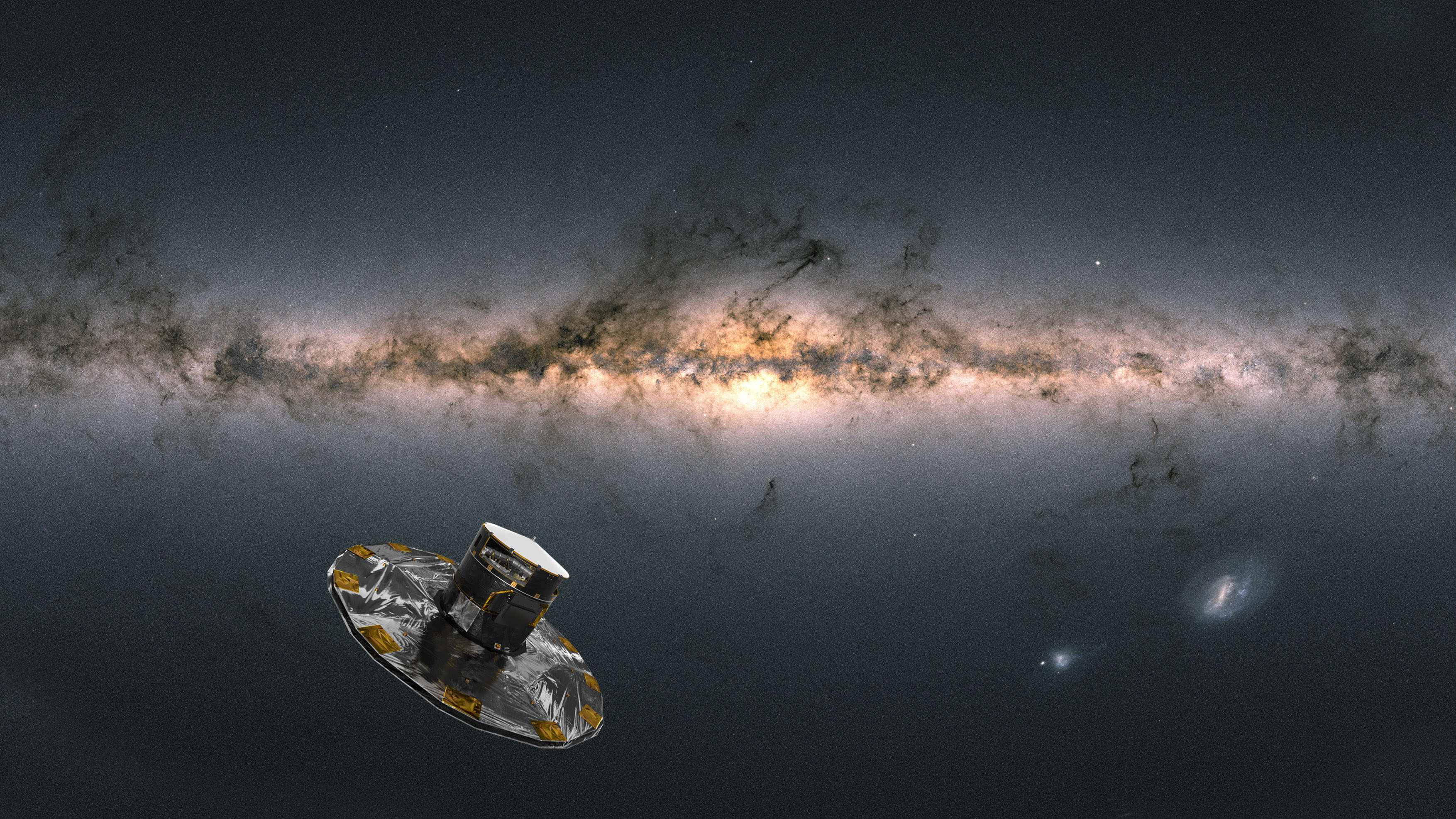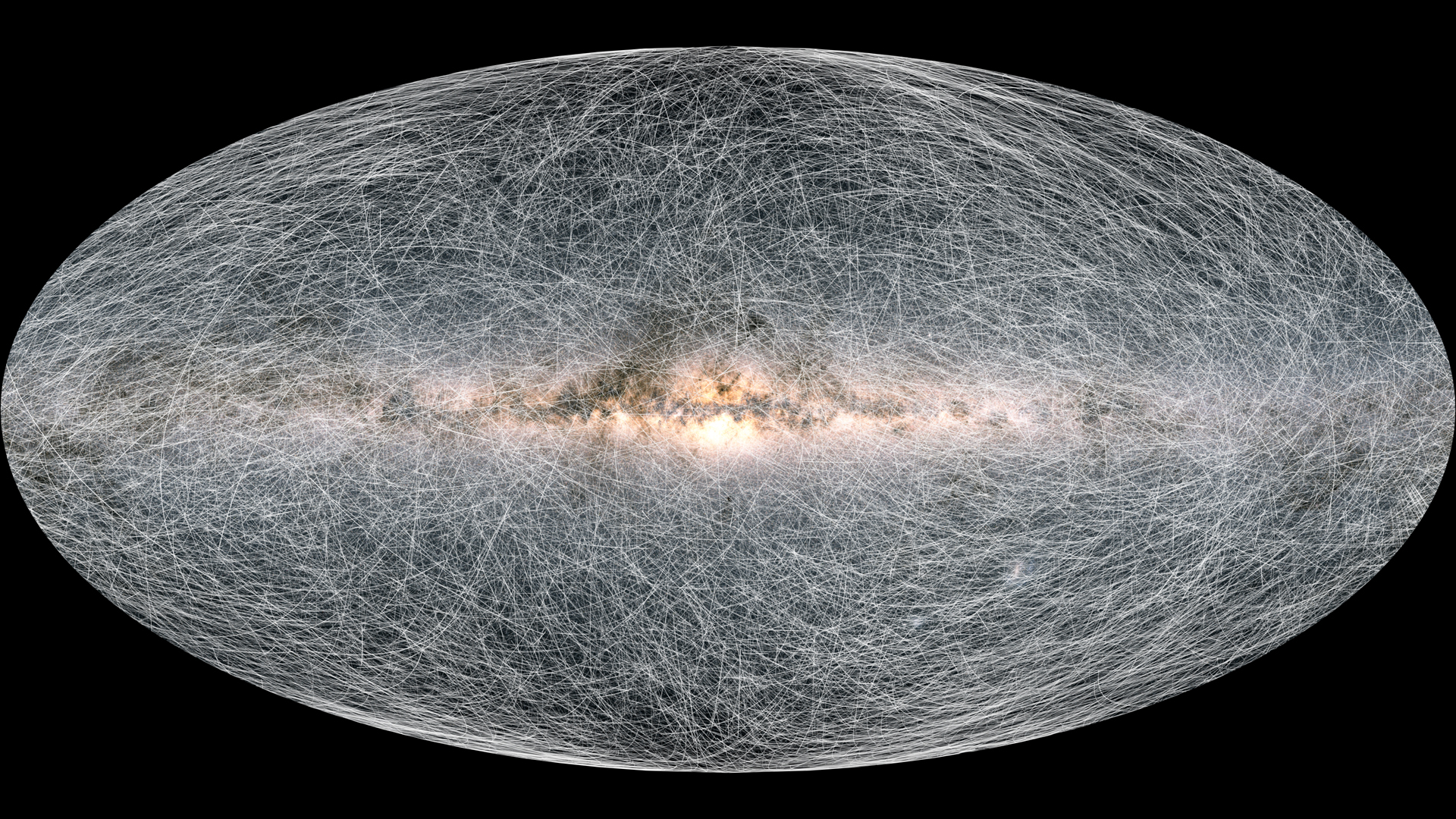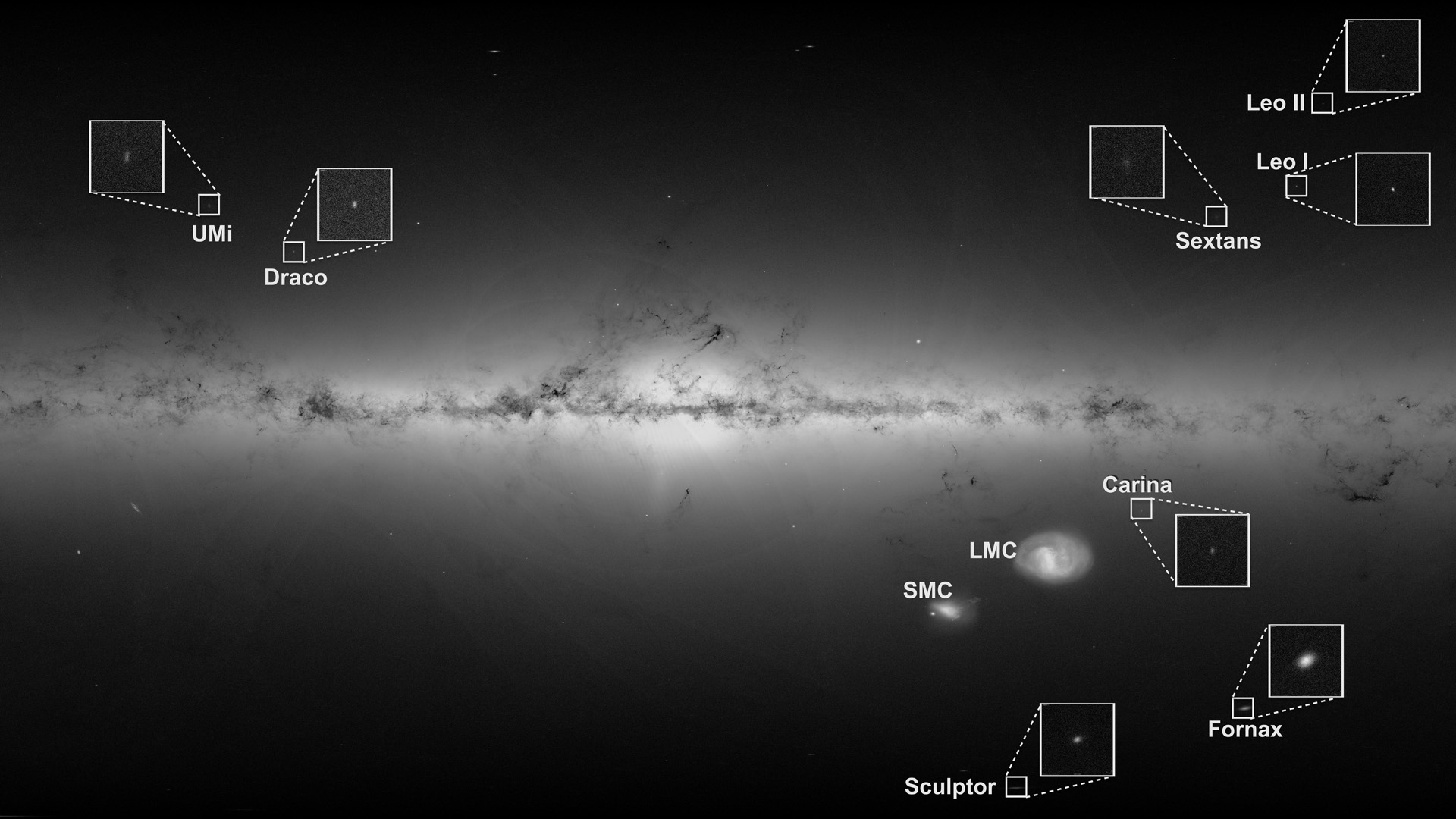Gaia spacecraft: Mapping the Milky Way like never before
Since its launch in 2013, the Gaia mission has revolutionized the study of our Milky Way galaxy.

The European Space Agency's (ESA) Gaia space telescope creates the most comprehensive map of our galaxy, the Milky Way. By measuring the precise positions, speeds and trajectories of about 2 billion of the brightest stars in the sky, Gaia enables astronomers not only to see the galaxy as it looks today, but also to replay the movie of its life millions and billions of years into the past and future.
While not such a household name as the Hubble Space Telescope or the James Webb Space Telescope, Gaia has revolutionized the study of the Milky Way and enabled leaps in our understanding of the galaxy's evolution that were impossible before. For many years, it has been the astronomical space mission producing the most scientific papers.
Since its launch in 2013, Gaia has released four batches of data, witch increasingly precise measurements and new types of information about the ages, masses, brightness levels and chemical compositions of stars in the galaxy.
The telescope has also created record-breaking data sets about asteroids in the solar system and binary stars in the Milky Way.
The telescope will remain operational until 2025, when it will run out of fuel. But the vast catalog of data the mission creates will keep astronomers busy for decades to come after that.
Related: 4 big Milky Way mysteries the next Gaia mission data dump may solve
How does Gaia study the Milky Way?
Nestled in the Lagrange Point 2, some 930,000 (1.5 million kilometers) miles away from Earth, Gaia orbits the sun in synch with our planet. Shielded by Earth from the sun's glare but also free from the distorting effects of Earth's atmosphere, which plague ground-based telescopes' observations, the flying-saucer-like spacecraft scans the whole sky every two months.
The 7.5-foot-wide (2.3 meters) Gaia satellite is attached to a 33-foot-wide (10 m) circular sunshield and is fitted with two telescopes that sit 106 degrees apart. The telescopes project the light they capture onto a 1-billion-pixel camera, which distinguishes the faintest details of the surrounding universe. Rather than create spectacular images, these telescopes enable astronomers to determine a few key parameters that reveal the distances of stars from Gaia, as wellas their positions and motions on the plane of the sky.
In addition to the two telescopes, Gaia also carries blue and red photometers that measure the brightness and color of the observed stars. From these measurements, scientists can derive temperatures, masses, ages and compositions of stars.
A radial velocity spectrometer is also on board Gaia. This instrument measures how fast stars move toward or away from Gaia but also reveals how these stars absorb light, which reflects their chemical composition.
The two billion stars that Gaia sees represent only about 1% of the galaxy's stellar population. But with the help of clever algorithms and a lot of scientific knowledge, astronomers can reconstruct the Milky Way as a whole from the mission's observations.
Every day, Gaia sends 20 to 100 gigabytes of data to Earth, which equals 850 million individual star observations. Before the wider scientific community gets its hands on the data and starts unravelling the galaxy’s mysteries, the Gaia Data Processing and Analysis Consortium (DPAC), consisting of over 400 researchers and software engineers scattered over six super-computing centers across Europe, spends years processing, calibrating and validating the data.
"Each star gets measured on average 75 times every five years," Stefan Jordan, one of the researchers of the DPAC team based at the Centre for Astronomy of the University of Heidelberg in Germany, told E&T magazine. "That means that when we start our work, we have many trillion individual star observations. We have to process this data into a catalogue that for each of the nearly two billion stars that we measure contains only five parameters for astrometry [the position and motion of stars], and then additional parameters for brightness and spectra."
According to the German Aerospace Centre (known by its German acronym DLR), the mission's final catalogue will comprise over a petabyte of data, which, if printed on paper, would stack up to 60 miles (100 km) high.

Why was it difficult to study the Milky Way before Gaia?
Before Gaia's launch, progress in the charting of the Milky Way was slow and painstaking.
"It's the same as if you are trying to tell the shape of a building while you are inside of it," Jos de Bruijne, Gaia deputy project scientist at ESA, said in a statement. "To understand the shape of the galaxy, you need to know where the individual stars are. But the stars are very far apart and very far away, and to accurately measure their positions in three dimensions requires extreme precision."
To put things into perspective, in the early 1990s astronomers knew the accurate positions of only about 8,000 stars, according to ESA. Advancing telescope technology enabled them to gradually increase the size of the stellar catalogs and improve their accuracy, but the effects of the atmosphere restricted their possibilities. Things only started properly moving forward after the launch of Gaia’s predecessor, ESA's Hipparcos mission, in the early 1990s. Hipparcos charted the positions of only about 100,000 stars, compared to Gaia's two billion.
"Hipparcos was built on 1980s technology," Floor van Leeuwen, the former head of the Gaia data processing team at the Institute of Astronomy in Cambridge in the U.K, who was involved in the Hipparcos mission as a young researcher, told E&T magazine. "There was very little memory on board, and the satellite had to communicate with the ground station constantly while observing. The detectors were much simpler, it couldn't see fainter stars and the whole mission was much less flexible."
The step change between Hipparcos and Gaia, van Leeuwen said, was mostly due to improvements in digital technology. Still, from today's perspective, Gaia's detectors and cameras might seem obsolete, though they were state-of-the-art in the early 2000s when the mission was developed.

What has Gaia discovered so far?
Since the release of the second batch of Gaia data in 2018, the mission has been steadily generating on average five scientific papers a day, which makes picking its highlights rather difficult.
This is how van Leeuwen explained the progress to E&T magazine in December 2020: "Only four or five years ago, I was still asked repeatedly by one of the senior professors at Cambridge University, 'What are the proper motions of the Magellanic Clouds? Have you measured them yet?' 'No, we haven’t,' I had to admit," van Leeuwen said. "Today, we not only know the proper motions of the Magellanic Clouds with extreme accuracy, but we also know what is happening inside them."
The Small Magellanic Cloud and the Large Magellanic Cloud are two dwarf galaxies orbiting on the outskirts of the Milky Way. The galaxies, Gaia data revealed, were only captured by the Milky Way's gravity a few billion years ago and will ultimately merge with it.
Every Gaia data release comes with the tag of the best Milky Way map to date, and that will remain the case with every future release as the data becomes more precise. The mission is also able to see increasingly distant stars and reveal new information, such as the chemical compositions of stars, which makes this map more and more colorful.
Gaia is also credited with virtually creating the field of galactic archaeology. Using sophisticated algorithms, astronomers sift through the mission's data looking for patterns in stars' motion. Since objects in space follow the laws of physics, astronomers can rewind the movie of the Milky Way's evolution billions of years into the past as well as into the future.
Gradually, they are piecing together the story of the Milky Way's life, finding evidence of ancient collisions through which the galaxy assembled into its current form, a massive spiral galaxy encompassing 200 billion stars.
Astronomers have found that, some 10 billion years ago, the nascent Milky Way smashed into another galaxy, which was about four times smaller than the Milky Way at that time. Remnants of this galaxy, which researchers have named Gaia Enceladus, gave rise to the Milky Way's halo, the sphere of thinly dispersed stars surrounding the much more massive galactic disc.
"At the moment, we think that [the collision with Gaia Enceladus] was the last significant merger that the Milky Way underwent," Anthony Brown, an astronomer at Leiden University in the Netherlands and chair of DPAC, told Space.com.
The increasing precision of the data but also the new parameters that are being released are allowing astronomers to look into the even more distant past.
Analysis of Gaia data also revealed that the galaxy's disk is warped, rather than flat, and wobbles like a spinning top. This wobble might have been caused by a collision with another dwarf galaxy, known as Sagittarius, and astronomers expect soon to learn more.
Gaia also helped answer some profound questions about the Milky Way's trademark spiral structure and the nature and character of its spiral arms, the thick winding streams of stars that appear to emanate from the galaxy's center.
According to De Bruijne, the mission is still going strong and further breakthroughs can be expected.
Gaia latest data release on June 13, 2022 includes the largest ever data sets of binary star systems in the Milky Way, as well as the biggest survey of chemical compositions of solar system asteroids. In the future, the team plans to focus on discovery of exoplanets orbiting distant stars.
Additional resources
Explore Gaia data visualizations on the mission's dedicated YouTube channel. For an in-depth dive into the mission's science and workings, visit the ESA Science Gaia website or the agency's main portal.
Bibliography
ESA, How does Gaia study the Milky Way?https://www.esa.int/Science_Exploration/Space_Science/Gaia/How_does_Gaia_study_the_Milky_Way
ESA, Why was it so difficult to study the Milky Way before Gaia? https://www.esa.int/Science_Exploration/Space_Science/Gaia/Why_was_it_so_difficult_to_study_the_Milky_Way_before_Gaia
ESA, Five fascinating Gaia revelations about the Milky Way https://www.esa.int/Science_Exploration/Space_Science/Gaia/Five_fascinating_Gaia_revelations_about_the_Milky_Way
ESA, Gaia: Science with 1 billion objects in three dimensions https://www.cosmos.esa.int/web/gaia
Join our Space Forums to keep talking space on the latest missions, night sky and more! And if you have a news tip, correction or comment, let us know at: community@space.com.
Get the Space.com Newsletter
Breaking space news, the latest updates on rocket launches, skywatching events and more!

Tereza is a London-based science and technology journalist, aspiring fiction writer and amateur gymnast. Originally from Prague, the Czech Republic, she spent the first seven years of her career working as a reporter, script-writer and presenter for various TV programmes of the Czech Public Service Television. She later took a career break to pursue further education and added a Master's in Science from the International Space University, France, to her Bachelor's in Journalism and Master's in Cultural Anthropology from Prague's Charles University. She worked as a reporter at the Engineering and Technology magazine, freelanced for a range of publications including Live Science, Space.com, Professional Engineering, Via Satellite and Space News and served as a maternity cover science editor at the European Space Agency.
- Elizabeth HowellFormer Staff Writer, Spaceflight (July 2022-November 2024)









